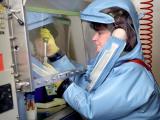Jul 17, 2002 (CIDRAP News) President Bush's National Strategy for Homeland Security, released this week, lays out a lengthy agenda for defending the country against bioterrorism as well as other kinds of terrorist attacks.
The 69-page report calls for numerous initiatives to prevent, detect, and respond to attacks with chemical, biological, radiological, and nuclear (CBRN) weapons. Many of the efforts are already under way as a result of supplemental public health funding that was approved last January and enactment of the Public Health Security and Bioterrorism Preparedness and Response Act of 2002 in June.
The president's proposed Department of Homeland Security (DHS) is assigned the lead role in most of the CBRN-related initiatives the plan describes, though the words "in consultation with the Department of Health and Human Services" appear often. The DHS proposal is now being considered in Congress.
The report calls homeland defense "an exceedingly complex mission that requires coordinated and focused effort for our entire societythe federal government, state and local governments, the private sector, and the American people."
The document groups defense efforts into six "critical mission areas": intelligence and warning, border and transportation security, domestic counterterrorism, protecting critical infrastructure, defending against catastrophic terrorism, and emergency preparedness and response. Most bioterrorism-related initiatives are in the section on catastrophic terrorism.
Most of the biodefense measures called for in the report fall into one of three broad categories: building systems for detecting biological and chemical attacks, developing new vaccines and treatments, and supporting state and local preparedness.
In the detection category, the report says the federal government will develop "sensitive and highly selective systems" to detect biological and chemical agents. For example, the Environmental Protection Agency is studying the possibility of equipping air-monitoring stations to detect certain CBRN substances. Also, the government will explore systems that can determine whether a person has been immunized against certain pathogens or has recently handled certain materials.
Further, the DHS will work with the Centers for Disease Control and Prevention (CDC), the Department of Veterans Affairs (VA), and state and local agencies to develop a national system to detect CBRN attacks, the report says. This system will include several programs and initiatives:
- The CDC's Epidemic Intelligence Service will be expanded and modernized to better train local and state officials to recognize attacks.
- The DHS will fund the hiring of epidemiologists for state and local jurisdictions of more than 500,000 population.
- Disease information will be shared securely through the recently established Epidemic Information Exchange System.
- The existing National Electronic Disease Surveillance System will link public health databases nationwide to identify disease outbreaks and unusual patterns.
The report also says the DHS, collaborating with the Department of Health and Human Services (HHS), will lead efforts to test whether illnesses or symptoms may be attributable to CBRN exposures and to set up disease/exposure registries.
In the research and development category, the report says the DHS and HHS will pursue new vaccines and drugs that are safer and more effective. "For example, they will explore the utility of attenuated smallpox vaccines and of existing antivirals modified to render those vaccines more effective and safe." The agencies will also support research on "broad-spectrum antivirals to meet the threat of engineered pathogens aimed at both humans and livestock."
The proposed National Biological Weapons Analysis Center, which would be part of DHS, will set research and development priorities by determining which CBRN threat are the most serious, according to the report.
Regarding state and local preparedness, the report says the DHS will work with HHS and VA to support biodefense training and equipment for state and local healthcare personnel. The agency also will run the existing grant program to help hospitals and poison-control centers prepare to deal with toxic attacks and increase their surge capacities. Other measures related to state and local preparedness include the following:
- The DHS will take control over the National Disaster Medical System, a federal-private partnership that "provides rapid response and critical surge capacities to support localities in disaster medical treatment."
- In consultation with HHS, DHS will manage the National Pharmaceutical Stockpile and will provide grants to help state and local agencies plan how to receive and distribute medicines from the stockpile.
In addition, the document calls for the updating of antiquated state quarantine laws. It says federal agencies, in cooperation with state and local governments, should review the existing laws and regulations and set minimum standards.
See also:
Executive summary of the National Strategy for Homeland Security, with link to the full report
http://www.whitehouse.gov/news/releases/2002/07/20020716.html


















